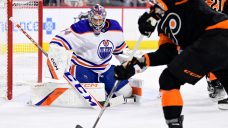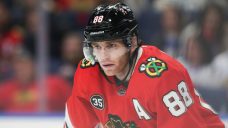EDMONTON — Things We (Think We) Know. Series 1, Volume 4.
Things We Know
Internally, the Edmonton Oilers are re-evaluating their needs heading into the March 3 deadline.
Two months ago it was all about keeping pucks out of their net. “We have enough offence. We need to shore up defensively,” was the theme, and hence, scouts were dispatched to watch players like Joel Edmundson, Vladdy Gavrikov and Luke Schenn.
But since the Christmas break the Oilers have limited opponents to 2.53 goals per game — fourth best in the NHL during that 17-game sample size. Their shots against per game (30.9) are still a tad high — ranked 18th — but they’ve surrendered just 29 five-on-five goals in 17 games.
And the saves percentage? Since Christmas it’s fifth best in the NHL at .918%.
So, as Philip Broberg takes another intriguing step, Brett Kulak raises his game, and big Vincent Desharnais shows that he’s just fine as a seventh defenceman, the thinking is changing to, “Is Edmundson really that much better than what we have? For a first round pick-plus?”
The target player is morphing from that second-pairing left defencemen to perhaps hitting the home run at forward.
“Why not?” some inside the organization are thinking.
And we’d agree.
Things We (Think We) Know
So, let’s define a home run.
I believe neither Erik Karlsson nor Jakob Chychrun are possibilities in Edmonton. If they went for a defenceman, maybe it’s Shayne Gostisbehere as a left-shot rental, but I doubt it.
A home run, on this roster at this moment, is a Top 6 forward. And at the top of that list is Patrick Kane.
Can you imagine a Top 6 with Connor McDavid and Leon Draisaitl at centre, Evander Kane and Ryan Nugent-Hopkins on left wing, and Patrick Kane and Zach Hyman on the right side?
That’s two first lines, in reality, on a team that plays 11 forwards and seven D-men — meaning one of McDavid, Draisaitl, or Nugent-Hopkins can cycle through the fourth-line. A third line of Dylan Holloway, Ryan McLeod and Mattias Janmark might be a tad young, but Derek Ryan could step up for some shifts if need be.
My sources tell me the Blackhawks would retain half of Kane’s $10.5 million salary, take Warren Foegele and Jesse Puljujarvi to make the money work, and require a first-round pick and a prospect — not Holloway or Broberg — in return.
That is super doable.
There is, however, one caveat: Kane’s wonky hip.
Can he withstand four playoff series’, with games every second night for two months? And don’t tell the Oilers that he can be a power-play specialist even if the hip is bad.
They really don’t need Kane on their power-play — it’s historically good already.
With the Rangers having snapped up Vlad Tarasenko, Colorado and Edmonton are two landing spots for Kane out West. But the hip will dictate.
Things We Know
Oilers GM Ken Holland texted the 31 other NHL GMs recently, informing them that Jesse Puljujarvi is available in trade. That would have been Holland’s response to the realization that he was going to have to place Puljujarvi on waivers in the coming weeks.
Things We (Think We) Know
We’re told that only three teams responded, and one (that we know of) is prepared to fashion a trade for Puljujarvi — but only after he clears waivers. Presumably, that team will want to start Puljujarvi in the AHL, and nobody wants to be the GM who trades for a player and loses him on waivers the next day.
Yamamoto is likely to return on Wednesday against Detroit, which means two players will have to be waived to clear the requisite salary to activate Yamamoto. Our friends at PuckPedia explain:
“The maximum a team saves in cap hit by sending a player down is $1.125M. So if anyone with a cap of $1.125M or more is sent down — from a cap perspective — there's no difference if they sent down Puljujarvi, Foegele, Ryan, Janmark… Sending any of those guys down clears $1.125M. And to activate Yamamoto, they need to clear $1.975M (Shore at $850K + someone at $1.125M).”
Barring an injury that could change the plan, you can expect Shore and Puljujarvi to be waived on Tuesday to make way for Yamamoto’s return, leaving Edmonton with a 21-player roster. By Wednesday afternoon, if Puljujarvi clears and that team is still interested, the fan favourite will be en route to Bakersfield or beyond.
Things We Know
Kailer Yamamoto has played 217 NHL games and scored 44 goals. We know how well he digs out pucks, that he is a tenacious, courageous checker who plays far above his diminutive weight class (five-foot-eight, 150 pounds).
But if he’s going to be a Top 6 forward — which means playing next to Draisaitl or McDavid — let’s talk about his goal scoring. He averages 0.2 goals per game played, or a goal every five games. That’s 16 goals per 82-game season, and over the past three seasons Yamamoto averages 0.45 points and 0.19 goals per game played.
Things We (Think We) Know.
A source said to me, break his production down by the month, and pay attention to March of 2022. So we did, using this season and the two previous ones.
Yamamoto, over two-and-a-half (plus) seasons, has 32 goals over 16 months. So he scores twice a month — except in March of ’22, when he scored eight goals. So, in the other 15 months, Yamamoto scored just 1.6 goals per month.
Does that define a Top 6 right winger, whether you use the two goals per month, or 1.6? No, it doesn’t.
At $3.1 million this year and next, Yamamoto is clearly not money well spent in the cap system. He’s making Top 6 money, but scores like a Bottom 6 winger. But even at less money, most GMs would say, “He’s too small for my Bottom 6.”
What kind of player is Kailer Yamamoto? He’s three contracts into his NHL career, and we’re still not sure.













































COMMENTS
When submitting content, please abide by our submission guidelines, and avoid posting profanity, personal attacks or harassment. Should you violate our submissions guidelines, we reserve the right to remove your comments and block your account. Sportsnet reserves the right to close a story’s comment section at any time.